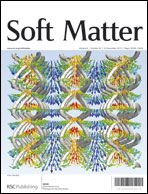The motion of a microgel in an axisymmetric constriction with a tapered entrance†
Abstract
The entrance of a microgel from a large channel into a narrow tube via a tapered entrance is described. The microgel was moved under a constant pressure difference, unlike previous works, which were implemented under constant flow rate conditions. The detailed relationship between the steady-state position of the microgel, the volume loss of the microgel and the applied pressure difference, ΔP, was established. Beyond a critical value, ΔPcrit, a steady state was not possible, and the microgel completely entered and traversed the constriction. ΔPcrit increased monotonically and non-linearly with microgel size. The variation of the microgel position and volume with ΔP were found to agree well with theoretical predictions. Also investigated was the relaxation of the microgel to its initial shape and volume upon exiting the constriction. It was discovered that the microgel relaxed to a spherical shape first, and swelled up to its initial volume later. It was also found that when adequate time was not provided for relaxation, the microgel could be forced into the constriction at a lower ΔPcrit. These fundamental results are expected to be useful in understanding the occlusion of blood vessels by soft particles, and in the design of hydrogels with specific relaxation properties.


 Please wait while we load your content...
Please wait while we load your content...